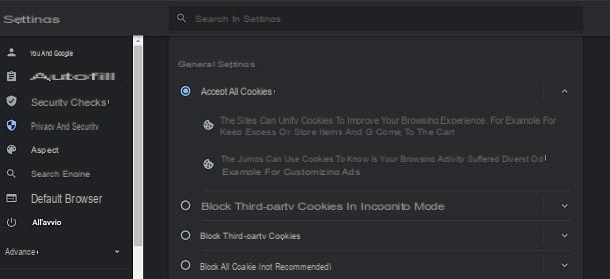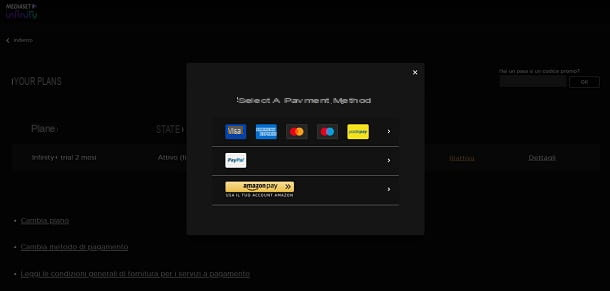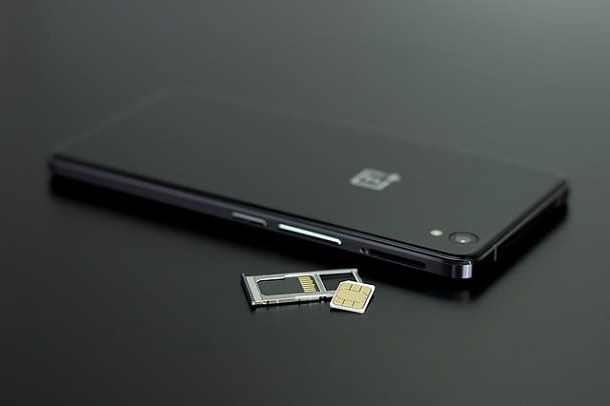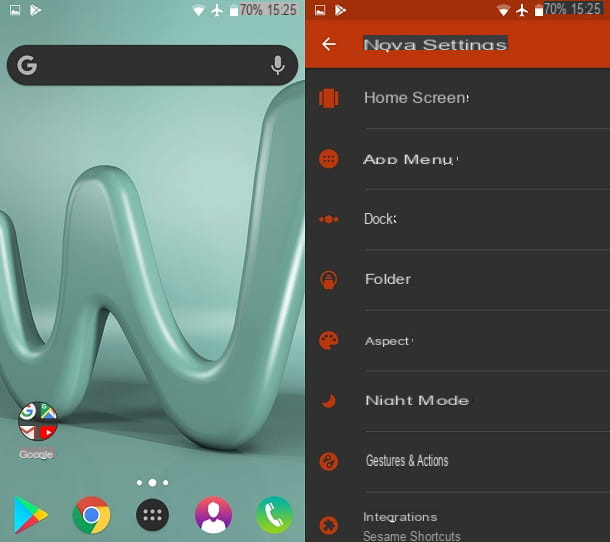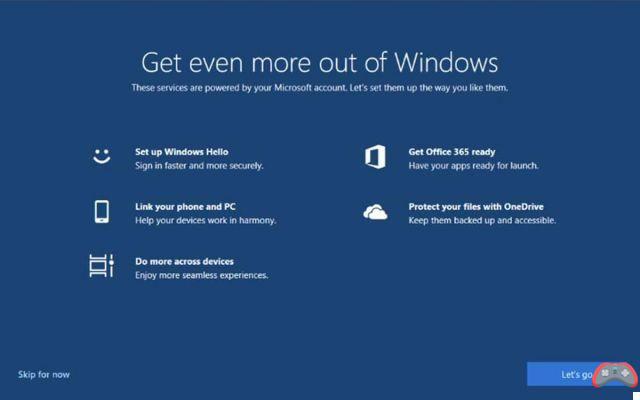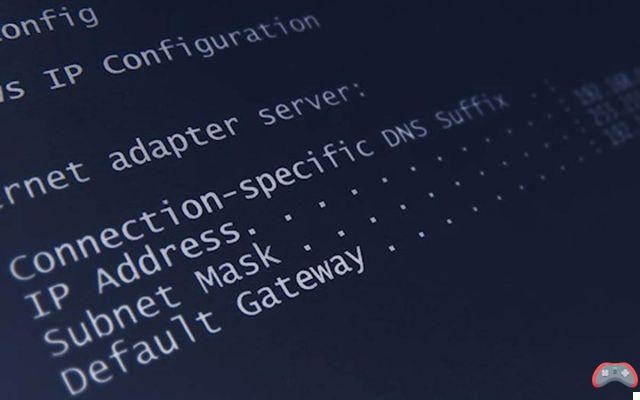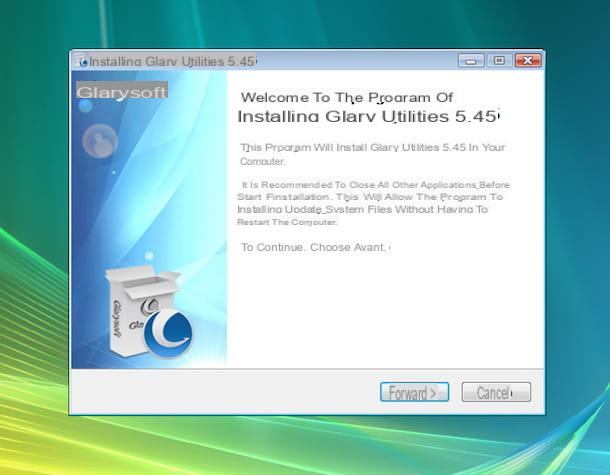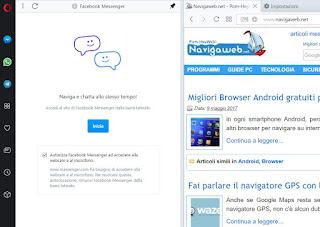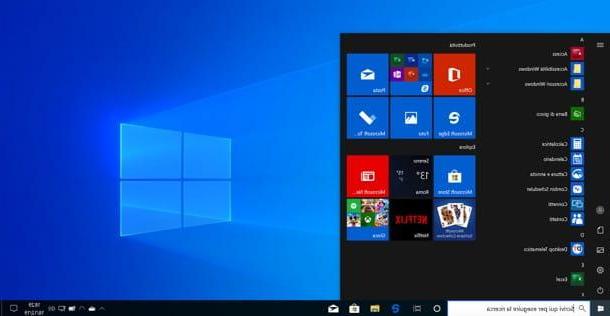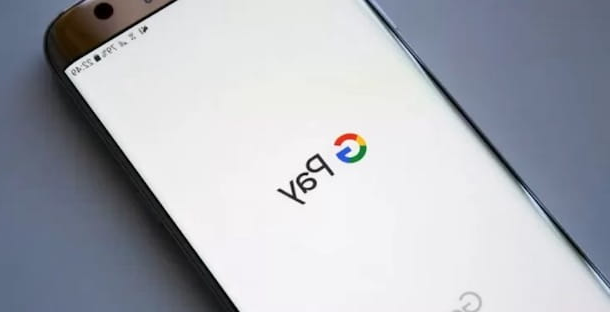Disable and Windows Defender
If you want to disable Windows Defender, you can install alternative antivirus software - and in this case the operation takes place automatically, as already mentioned at the beginning of the tutorial - or follow one of the procedures described below based on the version of Windows in use on your computer.
- Su Windows 10 Defender can only be disabled temporarily (for a few minutes or, at most, until the PC is restarted). To permanently disable it you must necessarily install a new antivirus, which will automatically take its place (otherwise you can try some "tricks" generally not recommended, such as those I reported in another guide). To proceed with the temporary deactivation, go to Windows settings (the icon ofgear present in the menu Home), select the items Update & Security> Windows Security> Virus and threat protection and click on your voice Manage settings relating to Virus protection. Then move up Disabled the levers relating to the functions Real-time protection e Cloud-Provided Protection I awarded her Yes, to confirm.
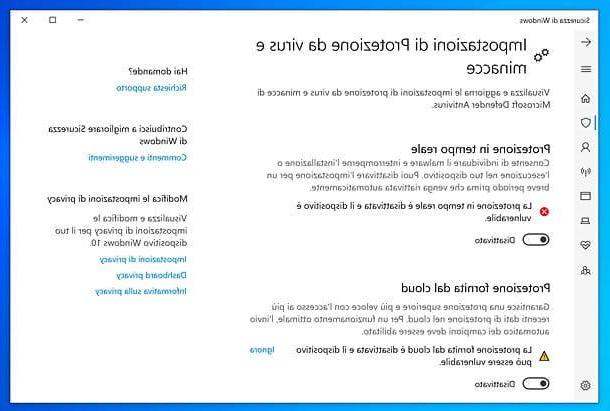
- Su Windows 8 / 8.x the procedure to follow is practically the same. You have to go to the Start Screen, search for the term defender and click on the item Windows Defender that appears in the search results. In the window that opens, select the tab Settingsclick sulla voce CEO located in the left sidebar, uncheck the item Activate app and click on Save Changes e Yes but I will complete the operation.
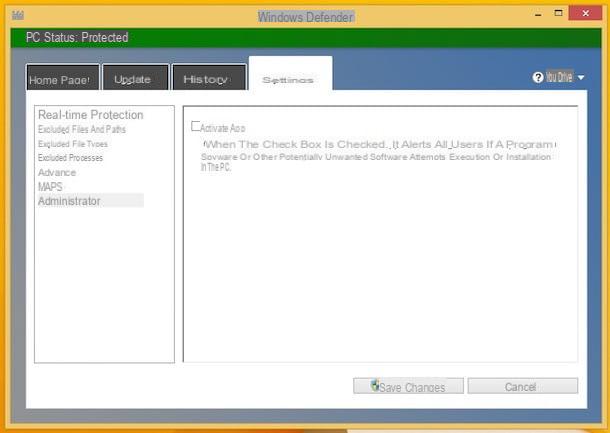
- Su Windows 7 o Vista, you have to go to the menu Home, search for the term defender and click on the item Windows Defender that appears in the search results. You must then select the tab Instruments from the window that opens, click on the icon options, select the item CEO from the left sidebar and remove the check mark from the item Use the program. Finally click on the buttons Save e Yes And that's it!
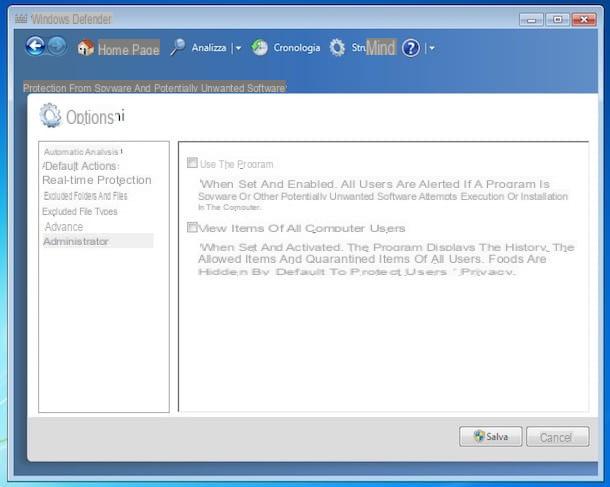
If you still use Windows XP (in this regard allow me to suggest you to evaluate as soon as possible to switch to a more recent edition of the OS as it is no longer supported by Microsoft and therefore subject to many security and compatibility problems), to disable Windows Defender you have to double click the program icon in the notification area (next to the Windows clock), then you have to go to Instruments, click on options and uncheck the item Usa Windows Defender.
Remove Windows Defender
Uninstalling Windows Defender is officially only allowed on Windows XP, where Defender is a program of its own. On the other versions of Windows, in which Defender is included "as standard", you have to manually remove the software following a procedure which, as anticipated at the beginning, is potentially risky for the stability of the system and, therefore, highly not recommended. Anyway, find all the details you need below.
It was used Windows XP, as just said, there are no problems. Go to the Control Panelclicca sull'icona Application installation, select Windows Defender from the list of programs installed on the computer and presses on Remove e Yes to start the complete removal of Defender.
On Windows 7 and later the situation changes a lot. Before you go to work, please, create a restore point system, do a registry backup and secure all important documents. The risk of making a mess is very high. If you do not know how to do it, to create a system restore point you can follow the instructions on the appropriate support page of the Microsoft website, while as regards the backup of the registry you can follow the instructions on this other page. .
It was used Windows 7, you can download theremoval utility of Windows Defender available at Raymond.cc and let it do all the "dirty work" for you. To download the utility, connected to the page I just linked to you and click on the item Download Windows Defender Uninstaller. Then start the executable Defender_Uninstaller.exe just got it, click on the button Uninstall Windows Defender and wait for the software uninstall process to finish. It is recommended that you perform the procedure after disabling Defender (as seen in the previous section of the tutorial).
Caution: It is not possible to use the Windows Defender Removal Utility on versions of Windows other than 7. You risk compromising system stability!
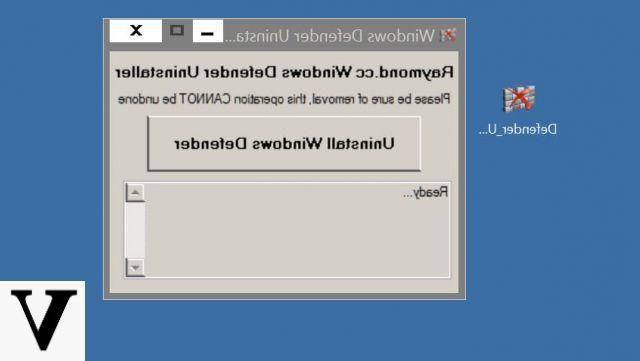
It was used Windows 8.x you have to delete Windows Defender "manually" by deactivating the program and deleting all the folders and registry keys that concern it. To do this, you need to use a free program: RunAsSystem which allows you to run programs with the highest administrative privileges. In this case, you will need to run the registry editor and delete the keys pertaining to Windows Defender.
After downloading the application, proceed to remove Defender from your computer by following these steps. The procedure can also be applied to Windows 7 if the aforementioned utility does not work.
- Start the Command Prompt with administrator privileges and give the commands sc stop windefend and sc delete windefend to close and delete the Windows Defender service;
- starts RunAsSystem.exe, type regedit.exe in the window that opens and press Submit to launch the registry editor with the highest administrative privileges;
- Find the key
HKEY_LOCAL_MACHINESOFTWAREMicrosoftWindowsCurrentVersionExplorerControlPanelNameSpace{D8559EB9-20C0-410E-BEDA-7ED416AECC2A}
- Right-click on the key and select the entry Permissions from the menu that appears. In the window that opens, click on the button Advanced, then go to the card Owner if you use Windows 7 or click on the item Change if you are using Windows 8. Then select the icon SYSTEM (if you are using Windows 7) or type SYSTEM in the text field that appears and click on Check names e OK (if you are using Windows 8), put the check mark next to the item Replace owner on subcontainers and objects and click on OK. When done, select the icon SYSTEM from the field Users and groups, check the item Allow and click on OK to save the changes;
- Delete the key;
- Repeat the whole process for the key
HKEY_LOCAL_MACHINESOFTWAREMicrosoftWindows Defender
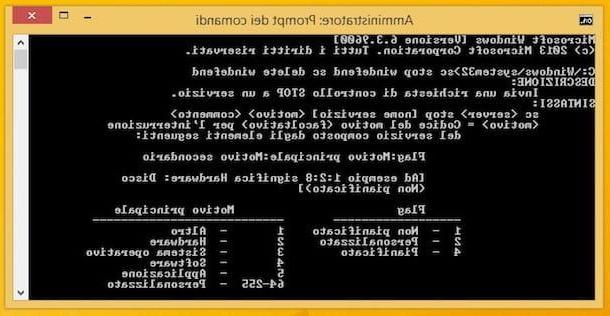
- Take control of the following folders and delete them from your computer.
- C: Program Files Windows Defender
- C: ProgramDataMicrosoftWindows Defender
- C:Program Files (x86)Windows Defender (sui sistemi 64 bit solo)
To gain control of a folder you need to right click on it and select the entry Property from the menu that appears. In the window that opens, you must then select the tab Safety and follow the same procedure described above for the registry keys. Alternatively, you can use third-party applications such as TakeOwnershipEx which installs a handy entry in the Windows context menu to gain control of folders.
Finally, restart your computer and you should be able to completely remove Windows Defender from your PC.
Cannot uninstall Defender from Windows 10 without compromising the stability of the system. More generally, I reiterate the concept according to which It is highly not recommended to uninstall Windows Defender (except on Windows XP). I do not take any responsibility for any damage you may cause to the system by attempting to follow the directions I have just given you.
In case of second thoughts
Did you follow the procedure to deactivate (“deactivate” not “uninstall”… look!) Windows Defender seen in the first part of this guide and now have you thought about it? No problem, you can easily fix it. Let's see immediately how.
- Su Windows 10, you have to go to the menu Home, type the term defender and click on the icon Windows Defender Settings that appears in the search results. In the window that is shown to you at this point, bring up ON the levers relating to the options Real-time protection, Cloud protection e Sending sample files and the antivirus will be activated immediately.
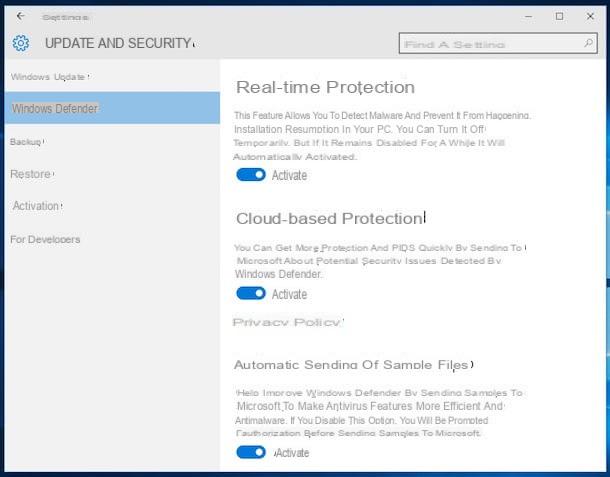
- Su Windows 8 / 8.x, you have to go to the Start Screen, search for the term defender and click on the item Windows Defender that appears in the search results. In the window that opens, select the tab Settingsclick sulla voce CEO located in the left sidebar, check the item Activate app and do up Save Changes e Yes to complete the operation. Then, select the item Real-time protection from the left sidebar, check the item Enable real-time protection (recommended) and click Save Changes to activate real-time protection against viruses and malware.
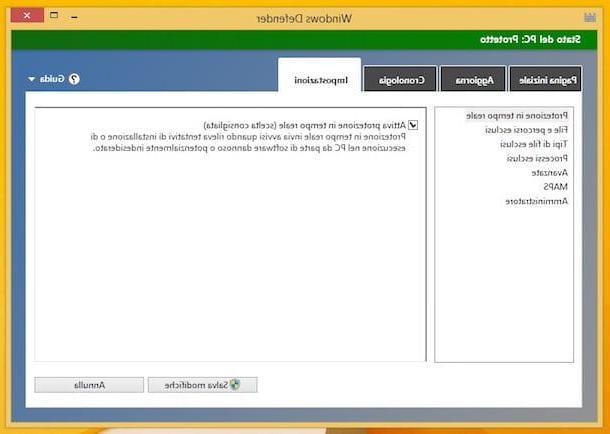
- Su Windows 7 o Vista, you have to go to the menu Home, search for the term defender and click on the item Windows Defender that appears in the search results. You must then select the tab Instruments from the window that opens, click on the icon options, select the item CEO from the left sidebar and put the check mark back on the item Use the program then click on the buttons Save. Then select the item Real-time protection from the left sidebar, put the check mark next to the items Use real-time protection (recommended), Analyze downloaded files and attachments e Analyze programs running on your computer and click the button Save to enable Defender's real-time protection against malware
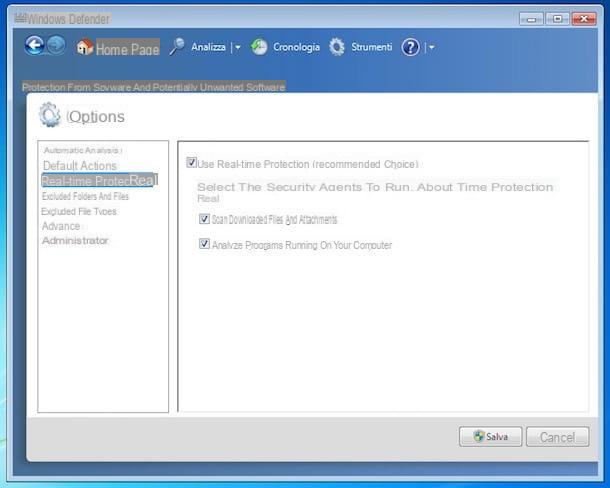
Have you followed the procedure to reactivate Windows Defender above step by step but there was some hitch? Don't despair! Try to put into practice the additional tips in my tutorial on how to activate Windows Defender and you will see that in no time you will be able to cope with it.
- It includes an antivirus module only from Windows 8. In previous editions of the operating system, the antivirus function was delegated to the free Security Essentials software. ↩






